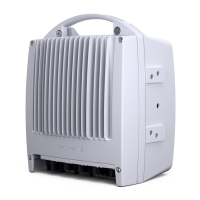MINI-LINKEandEMicro
2.2.4.2 Protected Terminal (1+1)
As a minimum, a 1+1 terminal consists of:
• Two RAUs
• Two antennas or one antenna with a power splitter
• One AMM 2U-3 (or AMM 4U) with two MMUs and one SMU
• Two coaxial cables for interconnection
4493
Figure 16 1+1 configuration r equires an AMM 2U-3 (AMM 4U can be used
as an alter native)
An SAU can also be added to the AM M to provide additional alar m and control
interfaces, service channels and other customer specific applications.
The radio units can be equipped with individual antennas or connected to a
common antenna. In the case of one common antenna, the two radio units
are connected by waveguides to a power splitter, fitted on a single-polarized
antenna.
Automatic switching can be in hot standby or in working standby (frequency
diversity). Receiver switching in space diversity systems is hitless.
In hot standby mode, one transmitter is working while the other one is in
standby (that is, not transmitting but ready to transmit if the active transmitter
malfunctions). Both radio units are receiving signals. The MMU selects the
best signal according to an alarm priority list, connects it first to the SMU for
demultiplexing and then to exter nal equipment. See Section 3.9.2.6 on page 58
for further information about switching.
In working standby mode, both radio paths are active in parallel using different
frequencies.
The 1+1 configuration should be considered for important and/or heavy traffic
requiring high availability, but also if there are severe reflections and/or harsh
atmospheric conditions.
14
AE/LZT 110 2012 R8C 2002-03-04

